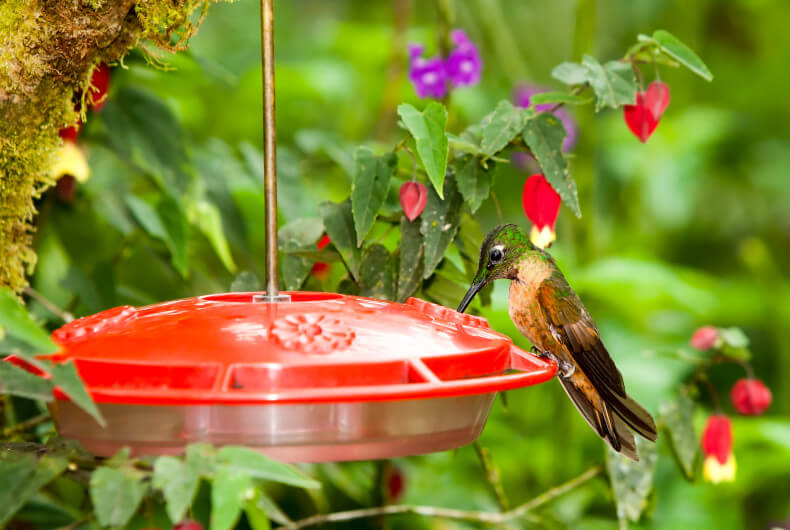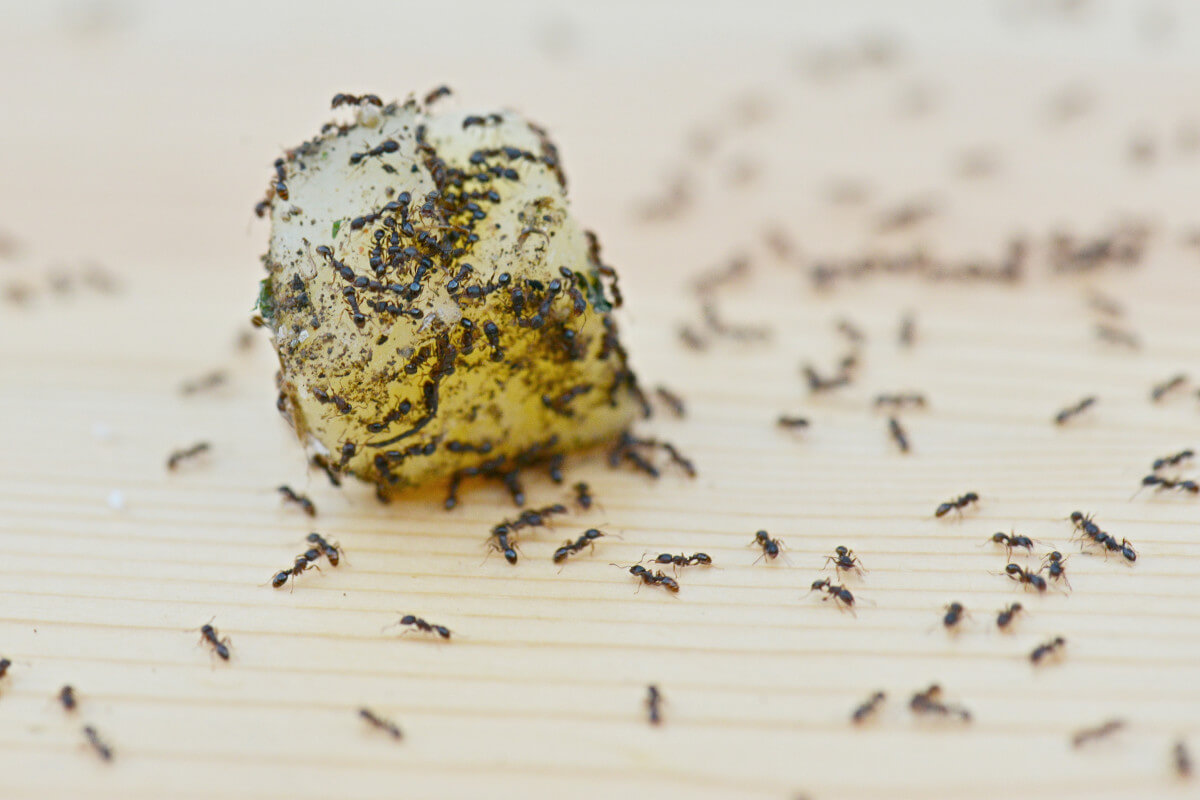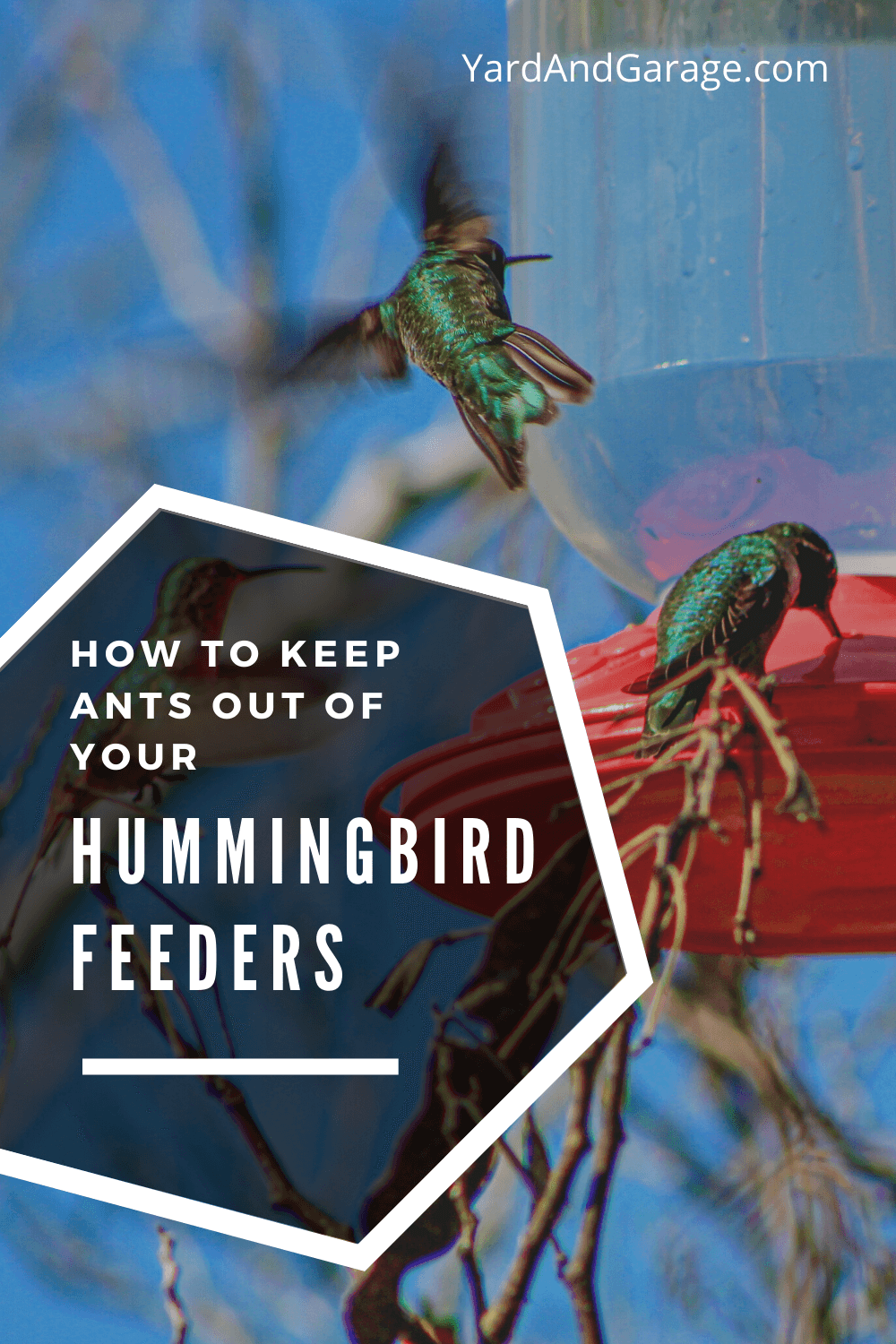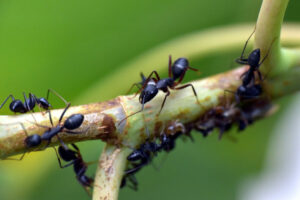 If you are an ardent hummingbird lover, you have probably tried and tested many methods to create a lovely place to attract hummingbirds to your garden.
If you are an ardent hummingbird lover, you have probably tried and tested many methods to create a lovely place to attract hummingbirds to your garden.
These iridescent birds love nectar, so that’s the first way to draw them to the hummingbird feeder in your backyard.
But unfortunately, ants love sugar as much as hummingbirds do!
While hummingbirds can eat insects, they would most likely avoid the ant-infested nectar altogether. However, if you are tired of ants keeping hummingbirds from eating from your bird feeder, this guide will help you.
Here are 15 ways to keep ants out of hummingbird feeders.
Table of Contents
Use an Ant Moat
An ant moat is arguably the most popular way to keep ants away from your hummingbird feeder.
It is a trap filled with water to prevent ants from crossing over towards the nectar. The water in the ant moat will dry out quickly in summers, so be careful about that.
There are three ways you can use ant moats.
Professional Ant Moats
You can purchase professional ant moats that are designed explicitly for hummingbird feeders to keep ants away.
Most of these have a bowl-type shape to store the liquid and hooks on either side to attach with the feeder.
You can strategically hang the ant moat above the hummingbird feeder, where ants would be caught before they can crawl towards the nectar.
DIY Ant Moats
If you want to save some money, you can make your own ant moat at home. Here’s how to build a DIY ant moat.
What you’ll need:
- Empty bottle with cap
- Drill
- Scissors or utility knife
- Coat hanger
- Hot glue
Steps to make a homemade ant moat:
- Use the scissors or knife to cut the upper part of the bottle, so you’re left with a bowl shape and cap. The cutting should be around 10-15 cm.
- Cut the bottom, the straight part, of the coat hanger.
- Drill a hole through the bottle cap and push the coat hanger hook through this hole.
- Turn the bottle upside down.
- Fill the cap with glue. Do not get any glue on the sides of the bottle, or it could warp, which would render it useless.
- Use a popsicle stick to stabilize the wire hanger to ensure the hanger is at the center of the cap.
- Wait 5-7 minutes for the glue to dry.
- Bend the ends of the hanger in the same direction.
Your ant moat is ready to be used!
Moats Built into Feeders
Alternately, you can purchase feeders with ant moats built-in. Fortunately, most hummingbird feeders have an ant moat, which makes your job much easier. You just have to hang the feeder in your backyard without worrying about ants invading the nectar.
Use an Ant Guard
While ant moats are pretty effective, these sly insects can sometimes manage to build a bridge and still find a way to the nectar. If your ant moat isn’t an effective deterrent for ants, you can use an ant guard.
An ant guard is a disc that contains Permethrin, a powerful insect repellent. Permethrin does not kill ants but simply drives them away. It is also safe for use around birds.
For example, you can use an ant moat and ant guard together to create a fortress for your hummingbird feeder!
Use Households Ingredients to Repel Ants from Feeders
Suppose you are skeptical of using chemical repellents to drive ants away from feeders. In that case, you can always look at simple household ingredients that repel ants. These are safe for you, your bird visitors, and your garden!
Bay Leaves
Bay leaves have a bitter smell that repels insects like ants, moths, and flies. You can add dried or fresh bay leaves around your hummingbird feeder to keep ants away.
Cinnamon
Ants hate the smell of cinnamon. So sprinkle some cinnamon around your bird feeder so ants won’t dare to venture any closer.
Coffee Grounds
Ants do not like the strong scent of coffee grounds, so sprinkle coffee grounds around your bird feeder to keep these insects away.
Mint
Peppermint works as a natural insect repellent as it interferes with their ability to communicate with pheromone markings. You can also rub or add some mint leaves around the bird feeder as ants hate the smell of mint!
Cayenne Pepper
Ants detest walking over powdery substances. In addition, the capsaicin in cayenne will act as an irritant for these insects, deflecting them from the bird feeder.
Vinegar
You can use diluted vinegar to spray around the bird feeder. The pungent smell of vinegar will dispel ants from entering the feeder.
Lemon Water
Ants hate the smell of lemon. You can spray lemon water solution around the feeder or use lemon peel to keep ants away.
Use Essential Oils That Repel Ants
There are many essential oils that you can use to create a natural insect repellent.
These include:
- Peppermint oil
- Tea tree oil
- Citrus oil
You can use all three to create a powerful deterrent for ants. Add 15 drops of peppermint oil, 15 drops of tea tree oil, and 7 drops of citrus oil to ¼ cup of water in a spray bottle.
Now spray this around your hummingbird feeder. Ensure you don’t spray it on the bird food, i.e., nectar, when using tea tree oil.

Relocate Your Feeders Often
Ants follow pheromone trails directly to the food source. Therefore, changing the location of the food source (the feeder) will throw them off! Keep ants away by regularly switching the feeder site from one part of the garden to another.
Fortunately, hummingbirds are adaptable birds, so this location change won’t make things difficult for them.
Use Fishing Line to Hang Your Feeders
Another great way to deter ants from the hummingbird feeder is to create a slippery and unstable trail for them. To do this, you can use a fishing line to hang your feeder.
The fishing line is so thin and slippery that several species of ants won’t be able to climb down towards the nectar without losing balance and falling off.
Use Feeders Designed to Prevent Leakage of Nectar
Ants use chemosensing to detect the presence of sugar. If you have nectar leaking from the feeder, ants will be able to find their way to the food source even more quickly.
Check for nectar leaks to prevent ants from entering the hummingbird feeder. Saucer or dish-style feeders hold the nectar below the feeding port and mitigate chances of leakage.
Keep the Feeders Clean
When hummingbirds eat from the feeder, nectar drippings are a common occurrence. Unfortunately, this invites ants to the feeder faster than ever.
This is why it is essential that you regularly clean the hummingbird feeder s well as the ant moat whenever you refill them. Ants love a sweet mess, so wipe the feeder down with a mild solution of hot water and non-toxic dish soap to keep these insects away.
Place the Feeders over Water
Ants may be able to crawl and climb, but they sure as hell can’t swim! If you have any water source in your garden, like a water fountain, hang your feeder over it with the help of mounting tools.
A birdbath will also attract hummingbirds, so this is a win-win situation!
Hang the Feeders Out of the Hot Sun
When bird feeders are exposed to the scorching sun, they will expand and possibly crack. Cracks in the feeder will lead to nectar leaks, which will attract ants.
To prevent this, do not place the feeder directly in the sun. Instead, hang your feeder in partial shade.
Moreover, if the sun is too intense, it will cause the nectar to ferment and ruin in just a few hours.
Remove Things Near Your Feeder that May Attract Ants
There are many things near your feeder that may be attracting large scores of ants. Make sure your feeder isn’t near any of the following:
Piles of Logs and Woods
Wood piles attract wood ants, and they can crawl up to your feeder if it is too close by.
Pet Food Bowls
You will attract an influx of ants around half-eaten food in your pet bowls. Instead, make sure the pet bowls are clean at all times without traces of food, or simply keep your feeder away from your pet’s food bowls.
Overflowing Trash Cans
Make sure there is no trash can or bin with half-eaten food near your bird feeder as this will attract ants, and they might then use their pheromones to find their way to the nectar in your feeder.
Use Plants that Deter Ants
Some plants act as natural deterrents for ants. You can either situate your bird feeder near any of these plants if they are present in your garden or just add their leaves around your bird feeder.
Tansy
The flowers of this plant can successfully deter the presence of ants through their strong scent. You can add tansy flowers to your bird feeder or grow their stunning plant in your yard.
Mint
Mint is a foolproof way to put off ants. These insects hate the strong, characteristic smell of mint, and you can grow several varieties in your garden to deter ants and for use in general cooking as well.
Lavender
Lavender is used in several insect repellants as it repels ants. So this plant would not only make a stunning addition to your garden but ward off unwanted insect visitors too.
Rosemary
Rosemary is just as potent against ants as mint. So it would make a great plant to deter ants and also serve use in cooking too.
Thyme
Thyme can prevent ants from entering the soil. Place your feeder over a thyme plant so there would be little to no ants to climb up to the hummingbird feeder!
Chrysanthemum
Mums successfully repel ants and several other insects. It contains Pyrethrin, which acts as an insect repellant but is safe for other animals.
Don’t Use Feeders with Yellow Accents
Many people make the mistake of using hummingbird feeders with yellow accents for that aesthetic appeal.
However, this may be attracting ants to your feeder as these insects prefer light colors like yellow and green. Yellow accents also attract other insects like wasps.
Simply use red hummingbird feeders to keep ants away from your bird visitors’ nectar!
Change the Ratio of the Food Source on the Feeders
If you want to keep ants away from the nectar in your feeder, simply dilute the mix, which will subdue the scent of sugar that attracts ants.
Nectar is usually made from 1 parts nectar and 4 parts water. To attract fewer ants, change the ratio by adding more water and less sugar.
The good news is, this still fulfills the hummingbird’s need for nectar!
Use Decoys to Lure Ants Away from Feeders
You can fortify your mission to keep ants away from the nectar by using decoys that lure ants away from feeders. To properly execute this, you should use a food substance to detour insects into another food source.
Place this trail (honey and water or sugar water) strategically, like on a branch leading up to the tree on which the feeder hangs.
Turn the trail right or left instead of going upwards towards the feeder. All ants will simply follow this trail as is characteristic ant behavior and never reach your hummingbird feeder.
However, this is just a temporary deterrent!
Things You Shouldn’t Use to Keep Ants Off Your Hummingbird Feeders
While the internet is full of information on how to keep ants off your hummingbird feeders, there are some things that you should never use.
Insecticides
Insecticides pose a significant risk to birds in the USA, so never use them to keep ants away from bird feeders! The chemicals in insecticides can be toxic to birds, which defeats the purpose of using them in the first place. In addition, aerosol particles in insecticide sprays can damage the hummingbird’s lungs.
Ant Traps
While ant traps seem like an easy and convenient way to get rid of ants, they are downright brutal. The idea is to get rid of ants, not to kill them!
Killing ants will disrupt the yard ecosystem as ants serve many purposes like pollinating flowers, fertilizing plants, and even providing food for birds! Any traps will do more harm than good to your birds and backyard wildlife.
Vaseline
Contrary to popular belief, petroleum jelly (Vaseline) is a huge no-no to keep ants from the bird feeder. It is not suitable for the birds.
Birds will get Vaseline on their feathers without the ability to clean it off. This will hamper their ability to fly and insulate themselves.
Adhesive Tapes
Using adhesive tape in bird feeders to keep ants away is a cruel way to get rid of ants and is extremely harmful to birds.
If hummingbirds come in contact with adhesive tape, they can get stuck and hurt themselves or even die from entrapment or severe injury to their feathers.
FAQs
Will ants in a hummingbird feeder hurt the birds?
Ants in the bird feeder will not hurt hummingbirds but surely keep them away. Hummingbirds do not like ant-infested nectar, so the presence of ants will just discourage them from entering your backyard.
How do ant moats work on a hummingbird feeder?
Much like other feeders, you can simply hang the ant moat on the hummingbird feeder. Add water or vegetable oil to it to prevent ants from crawling over the water and towards the nectar in the feeder. Since hummingbirds have long beaks, they can access nectar easily.
How do you make an ant moat for a hummingbird feeder?
You can use the same method as any feeder to make an ant moat for a hummingbird feeder. To find out how to make a hummingbird feeder ant moat, check out the DIY ant moats section in this guide.
Is it safe to use Vaseline to keep ants out of hummingbird feeders?
Vaseline can obstruct a bird’s ability to fly, so DO NOT use it on hummingbirds to keep ants away.
Does peppermint oil repel ants?
Peppermint is a natural insect repellent, and its aromatic scent can ward off ants from entering the bird feeder.
Final Word
Ants can be a nuisance as they feed on the nectar kept for hummingbirds in bird feeders. This guide informs you of 15 easy tips to keep ants away from the hummingbird feeders in your garden.
However, make sure that you employ humane methods to simply keep ants away, as killing these insects will just disrupt the ecosystem, which will ultimately harm birds!



